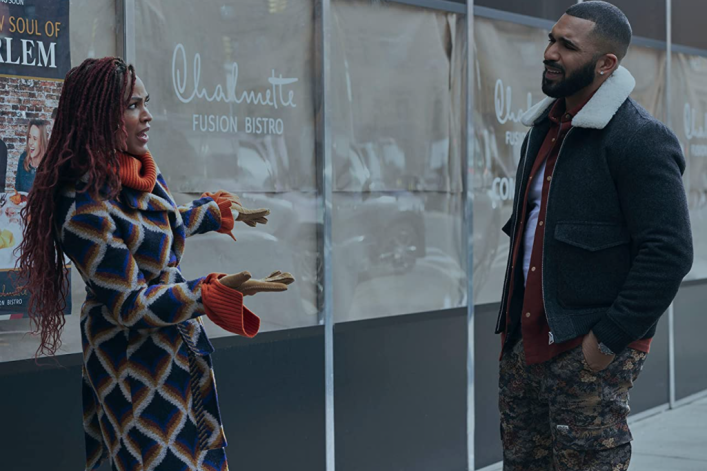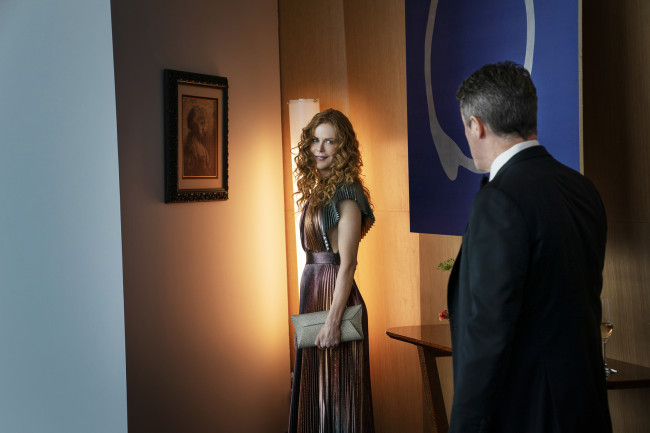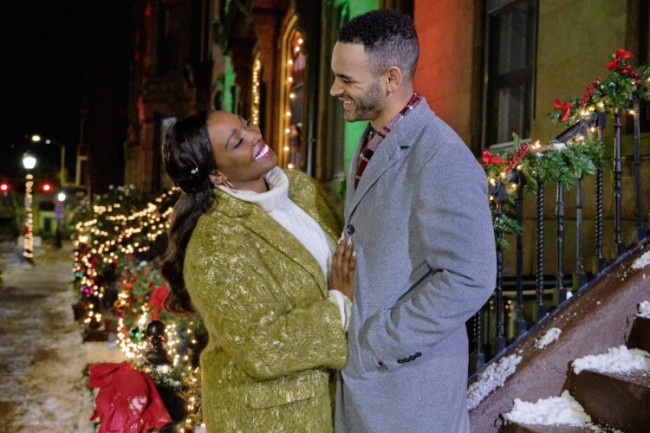In Amazon Prime's 'Harlem,' gentrification is part of the drama

Out with the old: Camille (Meagan Good) with Ian (Tyler Lepley), her ex-boyfriend, a chef who recently moved back to Harlem (with a new fiance) to run a new restaurant replacing Ray's, a Harlem mainstay.
The signage in the opening scenes of “Harlem,” a new 10-episode dramedy on Amazon Prime, mirrors the transformation underway in the neighborhood in real life: Mom-and-pop shops display “lost our lease” notices and trendy retailers like Sephora announce they are “coming soon.”
One of the main characters, Camille (played by Meagan Good), walks through her neighborhood, taking all of this in and tweets: “Will we live to see a time when a Sephora gets turned back into a jazz club #HarlemEverAfter…” The scene culminates with her coming across a “Welcome to SoHa” real estate sign on a LinkNYC box featuring a white male couple with their black son.
Even before we know who the characters are or what the show is about, we know it will involve New York City real estate. Indeed, gentrification is a central theme.
[Editor's note: When a movie or TV show is set in New York City—and if the people making it are savvy—real estate becomes part of the story itself. In Reel Estate, Brick Underground reality checks the NYC real estate depicted on screen.]
Turns out “Harlem,” created by Tracy Oliver with Pharrell Williams and Amy Poehler as executive producers, is about four black, thirtysomething female friends navigating city life, careers and romantic relationships. Certainly not new territory, but engaging nonetheless. Think: a mashup of “Sex and the City” and “Insecure.” The clothes are just as fab, the love interests just as dysfunctional, and the career struggles just as stressful.
The crew, all born and bred Harlemites, still reside there. Camille is an adjunct professor at Columbia with a PhD in anthropology; Tye (Jerrie Johnson) is a tech entrepreneur who created a dating app and is proud member of the LGBTQ community; Quinn (Grace Byers) is a fashion designer with wealthy parents who fund her lifestyle; and Angie (Shoniqua Shandai) is a mostly unemployed singer.
And like many shows that center around big city life, Harlem is also a key character. In fact, the show was filmed solely in NYC, and most of it was shot in Harlem. As a result much of the real estate featured makes sense, unlike another show that wanted us to believe Hartford could stand in for this neighborhood.
Tye and Quinn both live in huge loft spaces that are tastefully decorated with velvet couches, large-scale artworks and painted and wallpapered walls. Their places have large and airy rooms, wood floors, high ceilings, and original features. It’s not specifically said if they own but it is fairly safe to infer considering the very specific design in each. Most landlords would not permit in-depth alterations to a rental: Quinn’s all pink and purple décor is really a standout.
The lifestyles and professions of these New Yorkers appear to make sense too.
Tye is a self-made woman: She eagerly tells anyone who will listen she is being featured in Forbes—and lives a flamboyant lifestyle. Quinn also lives luxuriously. While her boutique is bleeding cash—the rent was just raised by $2500— her parents pay for pretty much everything. Angie doesn’t appear to have two quarters of her own to rub together; she lives rent-free with Quinn.
Adjunct professors typically don’t have big salaries —and so a plotline centers on how Camille is dying for a chance to become full-time and tenured at Columbia, if only for the health insurance. So, when we hear from her friends that her apartment is too small, it makes sense.
But then once we see her actual rental, something seems off. Camille’s rental is not small by NYC standards at all. Her bedroom is huge. There’s light and high ceilings and even a dining area! Her appliances are not old. This is the only real estate miss.
Also, the walls of her rental, which is in a brownstone, are painted different dark colors. Most renters are required to turn repaint their walls white when leaving, so New York renters usually steer clear of painting their walls inky dark shades.
It’s not until episode seven that we find out Camille is living in a rent-controlled apartment. Rent-controlled? No further explanation is given throughout the rest of the season and it begs many questions. How did she snag a rent-controlled apartment in Harlem? It is not that unusual to have a rent-stabilized unit—there are still many in Harlem – but there are far fewer rent-controlled apartments there—or in the city as a whole.
Who did it belong to before her? Apparently five years prior, she packed up and was set to move to Chicago with a boyfriend, so how did she regain control of that rental after ending her lease? Did she plan on subletting? Would that even be allowed? Real estate-inquiring minds want to know!
Fortunately for us real estate sticklers, the men that the three women date have believable living situations, even if they run the gamut from high end to well, homeless. Camille sees a highly educated and successful activist who lives in a fancy place of his own. Quinn dates a stripper who lives in a small, less-than-luxurious pad. And even down-on-her-luck Angie has a cute new man—he's an Uber driver who is living in his car! (That is a dealbreaker for her and she ends that relationship.)
The story lines weave NYC and real estate issues throughout the series as well. When an old Harlem standby, Ray’s, goes out of business and a new fancy fusion restaurant takes its spot, the women are upset and Camille hosts a protest.
Casual conversation also offers nods to actual Harlem neighborhood spots. To wit: “Whole Foods on 125th is the final nail in the gentrification coffin,” Camille huffs.
And in one early scene Camille waits outside of the Compass office of The Harlem Properties Team (located IRL on 2131 Frederick Douglass Boulevard).
All this bodes well for keeping viewers’ interest. The season closes on a romantic cliffhanger, offering hope for a second season. One can easily surmise future plotlines involving real estate: Angie finally gets a job and wants to rent her own apartment; Quinn wants to sell her pink palace and her agent advises to turn it back into a white box; and Camille gets offered a buyout for her rent-controlled pad.
All in all, “Harlem” offers a very stylistic and modern look at a unique neighborhood. The sense of community—both within the tight-knit quartet and the neighborhood itself—will resound with New Yorkers and non-New Yorkers alike.
You Might Also Like



























